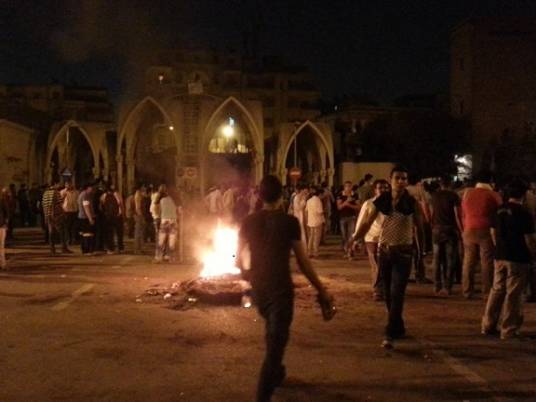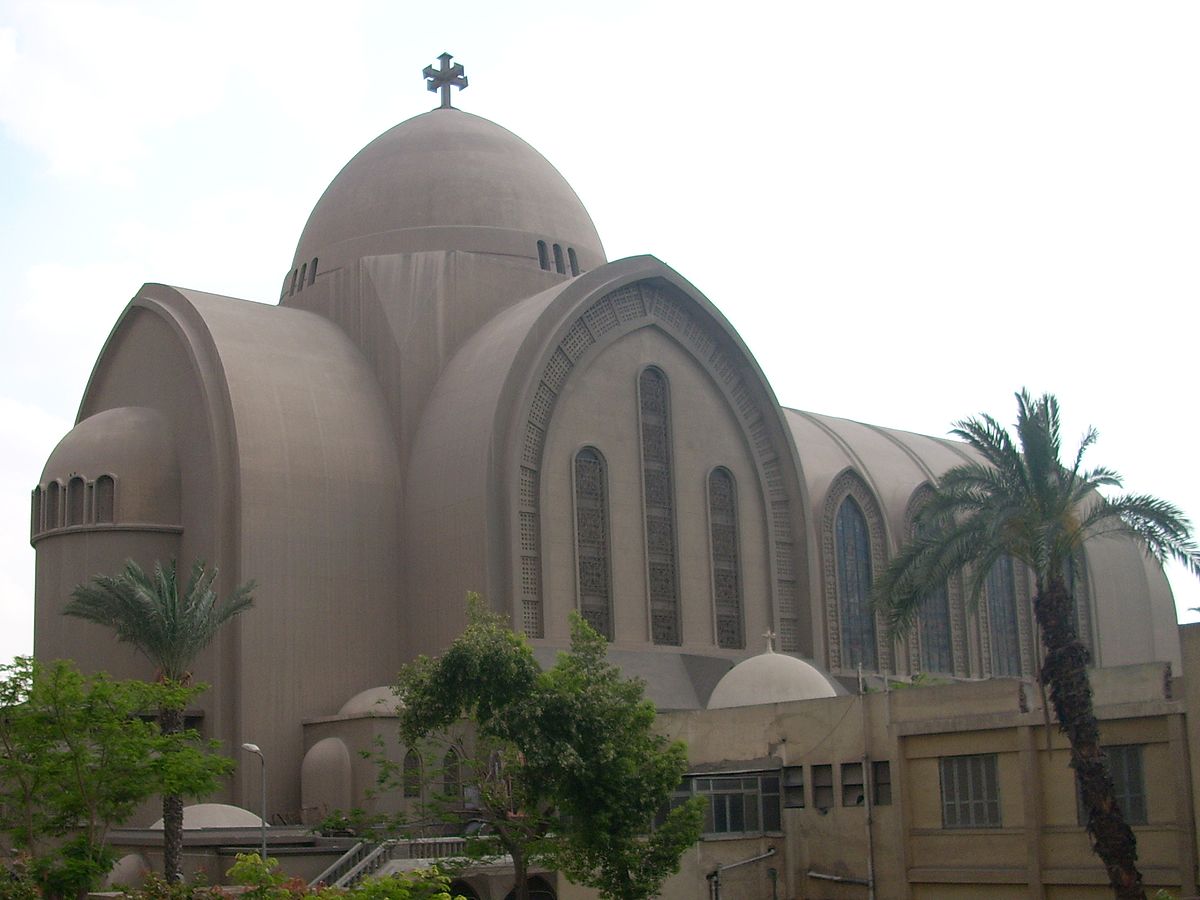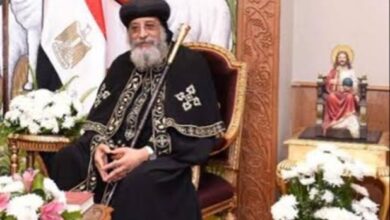
Coptic Pope Tawadros II called for calm among all parties to preserve the nation’s safety, Egyptians’ lives and national unity Sunday evening, after one person was reported dead and 29 injured in clashes at a Cairo cathedral that broke out after unknown assailants attacked a funeral.
Clashes have continued on and off after the first attack. Calm returned to the area by 7:30 pm Sunday evening amid a heavy security presence, but clashes broke out again after 9 pm, after unknown people threw stones and Molotov cocktails at the Copts inside, burning trees in the courtyard. The fire has been extinguished.
The attackers climbed to roofs of neighboring buildings, while Copts stranded inside the cathedral chanted slogans against the Brotherhood and the president, and harshly criticized police for staying in front of the cathedral, leaving the streets behind it open for attackers to use.
Morsy called the pope to follow up on the events, and told him that protecting Egyptian Christians and Muslims is the state’s responsibility, Al Jazeera Mubasher Misr reported late Sunday evening. Morsy also told Tawadros he considered any attack on the cathedral an assault on him personally.
Tawadros said in a statement that he and the bishops and priests had followed the unfortunate events and expressed his deep regret for them. The pope stressed that he is in constant contact with government officials, especially the interior minister, and is praying for the injured and martyrs.
Earlier Sunday evening, ONtv said one person was reported dead at the nearby Demerdash hospital and 29 people were injured in the cathedral clashes and attack, quoting head ambulance services. The channel also reported that clashes had erupted at the church in Khosous in the late afternoon, and that live ammunition was heard being fired from an unknown source there.
Al-Masry Al-Youm had said unidentified people were photographed firing birdshot from the Abbasseya cathedral roof, after clashes that resulted in the burning of cars parked outside the church. Police fired tear gas to disperse people throwing stones. But Al-Masry Al-Youm reporter Islam Diab denied the reports that Coptic youths at the cathedral had fired birdshot, in an interview with ONtv.
By 5 pm Sunday, the clashes in Abbasseya had renewed after a temporary halt, and Maspero Youth Union spokesperson Nader Shoukry told Al Jazeera Mubasher Misr that tear gas had been fired inside the cathedral there “without clear reason.”
Panic in the cathedral
By late evening, people were still stationed on the cathedral rooftops. One man there leaned on a cross and held a sign that read, “This is our country and we won’t leave it.”
In a side street outside, an Egypt Independent reporter reported that loud gunfire-like sounds could be heard. Residents said Muslims and Christians were firing at each other. No police were seen in the area.
Earlier, inside the cathedral, a group of about 30 people sang religious songs while at the main entrance, while youths on rooftops threw objects at assailants outside and burned objects to create smoke, the correspondent there reported.
A cathedral hall was turned into a field hospital, and an injured man told Egypt Independent he wanted to send a message to Morsy: “Why are you doing this to the Egyptian people? We want you to leave. Muslim, Christian, we want you to leave.”
Amid chaos and panic during the fighting before, a pickup truck full of men drove into the cathedral’s back entrance, and a man on the truck said the assailants were “killing us,” an Egypt Independent reporter at the scene said. Men showed their cross tattoos to get into the cathedral from the back entrance to defend it, and a bystander shouted, “This is democracy,” suggesting democracy had resulted in attacks on Copts.
Some mourners had refused to leave the cathedral despite the heavy tear gas, which was fired from the cathedral’s main gate, Egypt Independent’s correspondent reported. Copts who were in the cathedral mourning the deaths of the Khosous clashes victims say they are afraid the cathedral would be attacked if they leave.
Large numbers of young Christians arrived at the cathedral to defend it. Only a small back door was open, guarded by Copts to ensure that the attackers stay out.
Copts present at the cathedral resented the failure of police to protect the cathedral, the most revered symbol of Christianity in Egypt. Police were only present at the main gate, firing tear gas, while the building was left vulnerable to attack.
One of the cathedral workers recounted that unknown assailants, whom she suspected were Islamists, started insulting and attacking the mourners as the funeral procession left the cathedral.
“We don’t have a place here [in Egypt] anymore, they want to drive us out,” she said, as she walked away from the cathedral with dirt marks on her black clothes.
Standing inside the cathedral with a can of Pepsi that she sprayed at her face to ease the burning of the tear gas, an elderly woman refused to leave.
“We won’t leave the cathedral for them. Our youths are arriving now to protect it,” she said.
Panic spread in the cathedral among mothers who were afraid their sons now at the front line may face the same fate of those they came to the cathedral to mourn.
Already feeling wounded by the Khosous incident, the attack on the funeral increased the feelings of oppression among the mourners.
“No religion accepts this. We have learned since we were kids that death has its respect,” said one mourner, Moheb, as he escaped through the back door of the cathedral.
Moheb recounted that as the procession left the cathedral, it was attacked from above neighboring buildings. The mourners then rushed back in the cathedral and its door was closed, he said.
An elderly woman sitting outside the cathedral who lost contact with her son inside prayed that no more people would die Sunday.
“Please, God, don’t let the hearts of more mothers burn for their children,” she pleaded.
Ayman Adly, a plumber resting next to her, wearing his undershirt after having been at the front line, replied, “Death is better than what’s happening to us.”
Adly says the cathedral attack surpasses any other forms of oppression Christians in Egypt face.
“The cathedral means more than my honor to me. It’s our home, it’s the only thing in Egypt that’s ours,” he says. “We don’t have rights, we don’t have anything — this is all we have.”
But grief-stricken as he was, Adly still felt ownership in Egypt.
“We love this country,” he says. “No one will fear for it as much as us.”
Attack on a funeral
DPA quoted witnesses as saying earlier that attackers pelted the funeral procession with stones before security fired tear gas in an attempt to control the situation. State-run Al-Ahram newspaper’s website also reported the tear gas, but security source told the newspaper that some mourners had set fire to parked cars nearby, sparking the unrest.
Independent Al-Tahrir newspaper reported that its photographer Emad al-Gebaly sustained birdshot injuries while covering the events. Al-Shorouk reporter Bishoy Wasfy survived a successful surgery to extract fragments from a tear gas canister embedded in his neck and right shoulder during the clashes, though his doctor said the injury was critical and it is too early to determine his condition, Al-Shorouk reported on its website.
Meanwhile, Ramy Kamal, a member of the Maspero Youth Union, a coalition of Coptic activists, told DPA that following the funeral, some participants attempted to start a march from the cathedral to the Defense Ministry to submit a memo demanding more protection for Copts, but were surprised with unknown attackers shooting at them and throwing Molotov cocktails.
The clashes spilled onto surrounding streets as the funeral procession marched from the cathedral. A number of cars were smashed, and gunfire was also heard. Traffic heading both ways on Ramses Street ground to a halt.
Activists participating in the funeral unsuccessfully tried to calm the situation by asking mourners to go back inside the cathedral.
Most stores in the area closed their doors, as well as the gas station adjacent to the cathedral.
The initial clashes Friday broke out after a group of boys vandalized the wall of an Al-Azhar-affiliated building with graffiti. A confrontation that followed swiftly degenerated into armed clashes between groups of Muslims and Christians that continued until early Saturday morning, killing five people and injuring several others.
Attendees were earlier angrily chanting slogans against President Mohamed Morsy and the Muslim Brotherhood, including “down with the supreme guide’s rule,” reported satellite channel Al Jazeera Mubasher Misr.
Bishop Moussa, the youth bishop for the church, and Bishop Raphael, the secretary of the Holy Synod, performed the funeral mass for the four victims in the cathedral after Pope Tawadros II failed to attend, something which angered the families of the victims.
Bishop Raphael said in his sermon, “Not by bloodshed that the country will prosper, and not by the lack of security. A message to Copts: Stick to our faith, our ethics and our love, and we will not compromise on the ethics of the Gospel.”
Sectarian tensions have often flared into violence, particularly in rural areas, where rivalries between clans or families sometimes add to friction. Love affairs between Muslims and Christians and differences over the building of churches have also sparked clashed in the past.
Since former President Hosni Mubarak was ousted by a popular uprising, Christians have complained of several attacks on churches by radical Islamists, incidents that have sharpened longstanding Christian complaints about being sidelined in the workplace and in law.
The Abbasseya cathedral formally opened on 25 June 1968. Sunday’s events mark the first time tear gas has been used at the cathedral.
The violence in Khosous was the first major sectarian event since Morsy took office in June. Christians have experienced unprecedented attacks and violence since the 25 January revolution.



